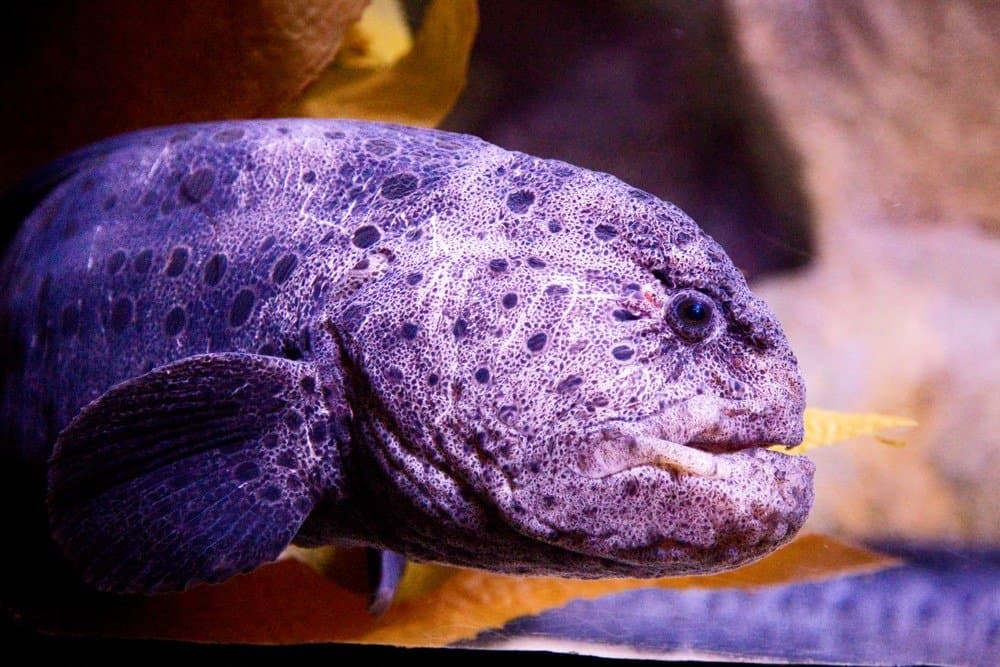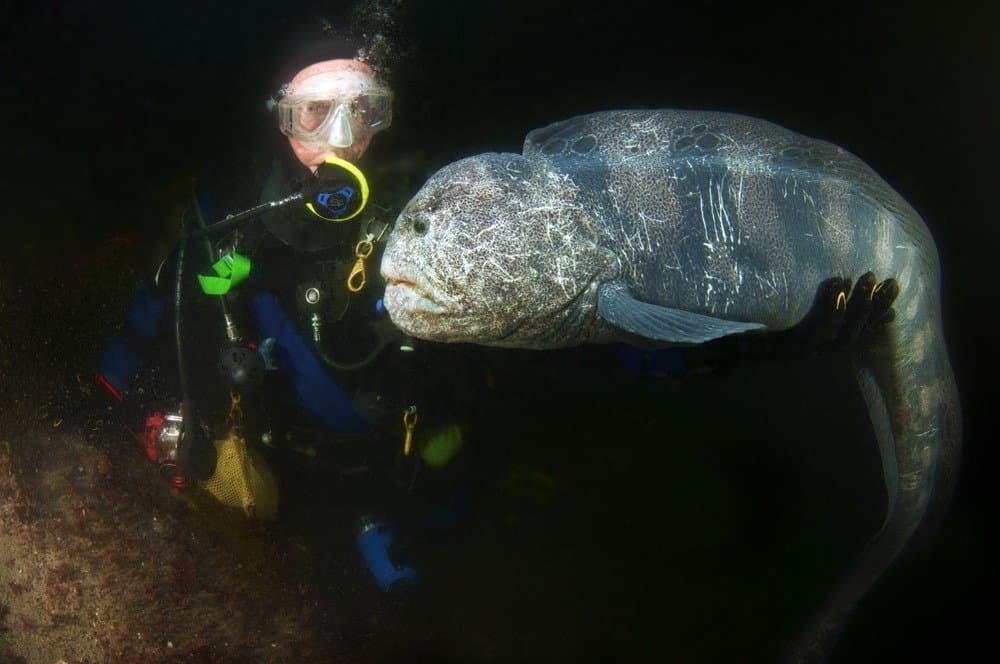Many of us are more familiar with terrestrial animals than aquatic ones. The reason for this is fairly simple – these are the ones we are more likely to see. However, there is a whole world full of unique creatures that live in the water. One of these fascinating animals is the wolf eel.
The teeth of a wolf eel are very important to this animal. They are a prominent part of its appearance, as well as its lifestyle. If you want to learn more about wolf eel teeth and what they can do, keep reading!
What Is a Wolf Eel?
The name “wolf eel” is actually quite deceptive. The truth is, the wolf eel is a fish, not an eel. The name comes from the fact that the body of this fish somewhat resembles that of an eel. However, they differ from true eels in that they have pectoral fins and paired gill slits.
The wolf eel is quite a long fish, reaching up to 8.2 feet, or 2.5 meters, in length as an adult. They can weigh up to 41 pounds or 18.4 kilograms. Generally, they are gray in color with numerous black bands and spots all over their bodies.
Wolf eels can sometimes have brownish or olive coloring as well. The female wolf eel is typically significantly darker than the male in color. Juvenile wolf eels tend to be brighter colors, with purple and orange highlights.
These animals live in the northern Pacific Ocean, between the Aleutian Islands and the Sea of Japan and Southern California. Typically, wolf eels inhabit stone and rock crevices, caves, and dens within reefs. This is very important because it plays an instrumental role in their ability to hunt and use their teeth to catch prey.

A wolf eel is not actually an eel, but it is a type of fish.
©Michaelpuche/Shutterstock.com
Do Wolf Eels Have Teeth?
The wolf eel has multiple rows of teeth. There are three rows on the upper jaw and two on the lower jaw. In the front of the mouth, the canine teeth are notably spiky and sharp. Typically, there are four to six of these teeth, which have a conical shape.
Wolf eel teeth have somewhat of a round shape in the back of the mouth, and an adult wolf eel can have dozens of molars. They have three rows of molars on the roof of the mouth, as well as two rows on the bottom jaw.
The teeth in the front resemble fangs and are meant to pierce the wolf eel’s prey. The rows of strong molars towards the back of the mouth crush and grind the prey so that the wolf eel can swallow it.
Do Baby Wolf Eels Have Teeth?
Juvenile wolf eels are much more vulnerable to predators than their adult counterparts. They are significantly smaller, and their jaws are not powerful at this point.
Although wolf eels are voracious eaters at all ages, their diet changes throughout their lives. Juveniles have underdeveloped jaws and teeth, so they generally feed on plankton. Adult wolf eels are able to hunt and prey on different types of animals.

Wolf eel teeth consist of three rows of molars on the top and two rows of molars on the bottom, plus two fangs to pierce prey.
©USEPA Environmental-Protection-Agency / public domain – License
What Do Wolf Eels Eat?
The diet of the wolf eel consists of fish, in addition to marine animals with hard shells, including echinoderms and crustaceans. In order to eat, they maneuver their long bodies into different crevices in their habitat and only stick their heads out. They wait for a crunchy animal to swim by for them to bite down on.
The jaws and teeth of wolf eels have specifically adapted to be able to crunch down on the hard outer shells of animals such as sea urchins, crabs, snails, sand dollars, abalone, clams, and mussels.
Even though their jaws and teeth are adapted to crush crunchy prey, they have been observed in captivity to prefer soft food, such as squid, when given the choice. However, this can actually damage their back teeth.
Wolf eel males and females mate for life and then tend to their clutches of up to 10,000 eggs. The eggs incubate for four months before hatching. During this time, the male and female take turns leaving the clutch to hunt for their prey. Seeking food is thus a very important part of the routine and survival of the wolf eel.
Do Wolf Eels Have Predators?
Adult wolf eels are not as vulnerable to predators as their juveniles. The appearance of this fish is intimidating not only to humans but to other animals as well. The visible teeth, large eyes, and rugged appearance help an adult wolf eel scare away many potential predators.
However, these adults are still somewhat vulnerable to becoming prey to larger eels, seals, sharks, and other large aquatic predators.
Because juvenile wolf eels are smaller and do not have the same intimidating appearance in jaw strength, they are more vulnerable at this stage. They can more easily fall prey to even smaller predators, such as rockfish and kelp greenling. Wolf eel eggs can also be vulnerable to these small predators, particularly if they are not being closely guarded by a parent.

The wolf eel’s appearance along with the protruding jaw and fangs make adult wolf eels look intimidating to potential predators.
©Greg Amptman/Shutterstock.com
Do Wolf Eels Bite Humans?
Wolf eels can cause their prey a great deal of pain, but they are not ferocious or dangerous animals outside of this situation. They move very slowly and are very sedentary in general. They can be somewhat curious, but humans should not fear them.
Although wolf eels are not often aggressive, they are capable of biting humans in certain situations. Because their jaws are so strong and their teeth are so sharp, these bites can be extremely painful.
Generally, if humans stay away from wolf eels, they will be safe. However, people who go diving may encounter wolf eels in dens at the bottom of the ocean.
Some people may have good intentions when they choose to feed the wolf eels. However, more than likely, this is just going to lead to the wolf eel associating that person with food. Because of the strong feeding instincts of the animal, this could lead to a bite. Wolf eels may also bite in self-defense when anglers accidentally catch them.
The photo featured at the top of this post is © Greg Amptman/Shutterstock.com
Thank you for reading! Have some feedback for us? Contact the AZ Animals editorial team.






